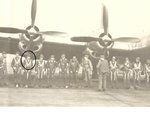Downwind.Maddl-Land
Airman 1st Class
OK, here's a question ref the B-29's gunnery system. Does anyone know why, alone among the gunners, the tail position couldn't be allocated control of any of the other turrets?
It seems strange that the most effective sighting position (ie the tail) couldn't be allocated control of the lower rear turret, especially as the waist gunners could be allocated control of the tail guns. I can understand why the tail position might not be given the rear upper turret due to arc of fire constraints caused by the tailplane and fin – it probably wouldn't be usable over a large degree of the tail gunner's cone of engagement - but I would have thought that the lower rear turret would have provided a welcome addition to the tail gunner's weight of fire.
While on the subject, when the 20mm cannon was removed (Due to trajectory/reliability problems), why wasn't it routinely replaced by another 0.5 calibre? I understand that this was done on some B-29Bs, so the engineering fix was available. Anyone with any knowledge or comment on the subject?
It seems strange that the most effective sighting position (ie the tail) couldn't be allocated control of the lower rear turret, especially as the waist gunners could be allocated control of the tail guns. I can understand why the tail position might not be given the rear upper turret due to arc of fire constraints caused by the tailplane and fin – it probably wouldn't be usable over a large degree of the tail gunner's cone of engagement - but I would have thought that the lower rear turret would have provided a welcome addition to the tail gunner's weight of fire.
While on the subject, when the 20mm cannon was removed (Due to trajectory/reliability problems), why wasn't it routinely replaced by another 0.5 calibre? I understand that this was done on some B-29Bs, so the engineering fix was available. Anyone with any knowledge or comment on the subject?


